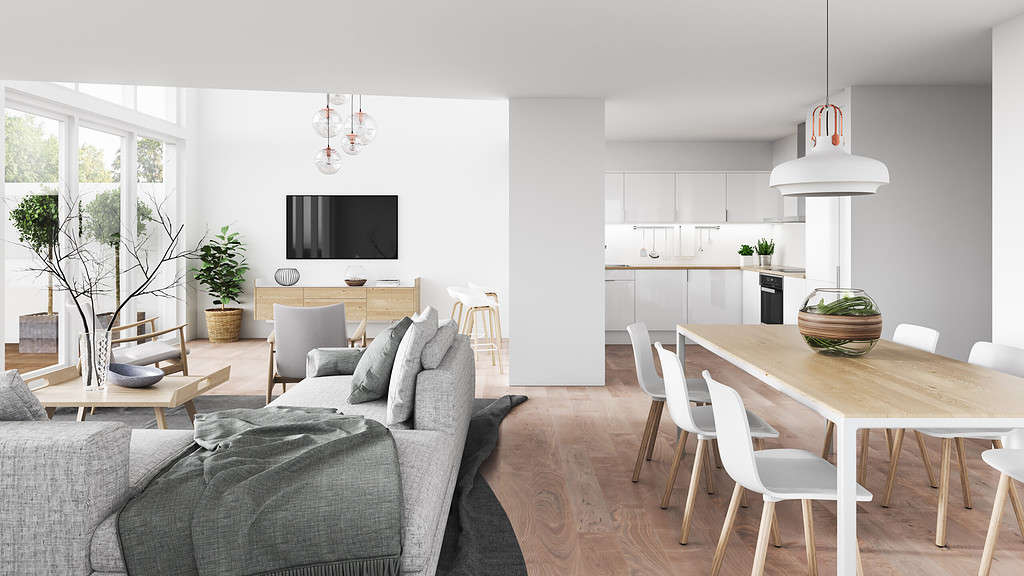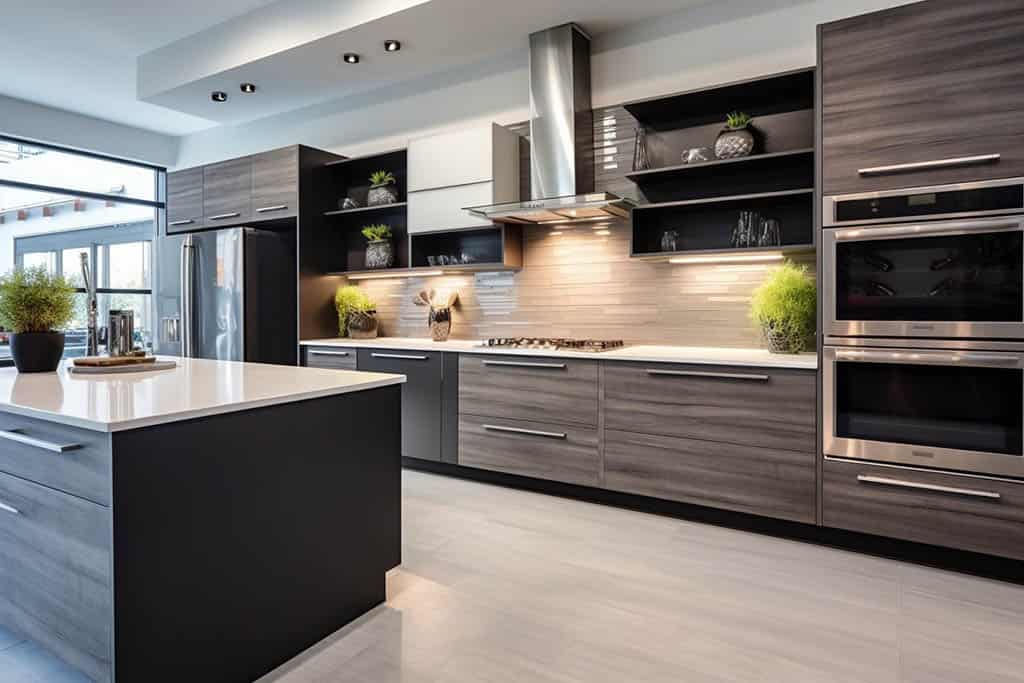
Due to how often we spend time in the kitchen, it’s one of the areas that is most prone to wear and damage. Australian homeowners update their kitchens the most of any room in their house. Since kitchen renovation might be budget-burdening, there are other considerations on how to make your kitchen look good, such as kitchen cabinet refacing and refinishing.
Refacing of kitchen cabinets
The kitchen cupboard refacing project is intended to give your kitchen a customized update without the need to remove cabinets or countertops. Refacing a kitchen island and cabinets can transform the look of your kitchen at twice less cost than a complete kitchen replacement.
How does kitchen refacing work?
Refacing kitchen cupboards is the process of replacing the existing drawer fronts, and cabinet doors with new ones. To reface kitchen cupboards you may also have to replace hardware like hinges, drawer slides, pulls, and handles. The main advantage is that you keep the cabinet boxes in place. If necessary, they may be repaired so they match the new surface or doors.
To complete kitchen cabinets and kitchen island refacing, you should assess the condition of your existing cabinets to ensure they are suitable for refacing. This includes evaluating the structure, ensuring the cabinet boxes are in good condition, and checking if the layout meets your needs. Then the existing cabinet doors and drawer fronts are removed, leaving the cabinet boxes in place. After that, you can decide whether to refinish the cabinet doors by painting or staining them, to update them with new wood/laminated veneer, or to completely reface kitchen cabinet doors.
The cabinet carcass might be also thoroughly cleaned and prepared for the application of the new veneer or laminate. After this, the updated or customized new doors and drawer fronts are installed, featuring the kitchen cupboard refacing ideas of your choice.
Why to reface kitchen cabinets?
In this exploration, we uncover the compelling reasons why modern kitchen cabinet refacing stands as a beacon of practicality, affordability, and aesthetic reinvention.
- It’s sustainable and eco friendly as decreases the consumption of wood materials, so saves a forest and reduces waste;
- Its economy, as refacing costs up to 40 percent less than replacing an entire cabinet set;
- It’s far faster to reface kitchen island and cabinets than choosing and ordering a new-brand kitchen;
- It does not require measurements so you don’t have to worry about fitting mistakes;
- It offers plenty of design options for doors and hardware
When refacing is not your option?
While most of the old kitchen cabinets can be refaced to look new, not all are. When deciding whether to replace or reface kitchen cabinets, there are a few factors to keep in mind:
- To reface cupboards in the kitchen might not be the best solution if your cupboards have lost their density;
- Your cabinets were warped or extensively damaged by water or termites;
- For a kitchen reface cabinets might not be sufficient if you struggle for more kitchen storage or going for a layout change.
Laminate kitchen cabinet refacing
You can reface almost any cabinet. The best results will be achieved by refacing oak kitchen cabinets or MDF, though. The most common after solid wood is laminate cabinets. Laminate, a versatile and durable material, offers a myriad of design options, allowing you to achieve a fresh and contemporary look for your kitchen. However, it is prone to faster fading and wear and tear, so may require more frequent refacing of laminate kitchen cabinets.
Cabinet surfaces are thoroughly cleaned and new materials are prepared for the laminate refacing of kitchen cabinets. This involves the existing laminate layer sanding down and priming to ensure proper adhesion. Then, new laminate sheets are carefully applied to the cabinet surfaces, providing a fresh and cohesive look. The adhesive ensures a secure bond, creating a seamless finish. Once the laminate is applied to cabinet doors, the edges are properly sealed to avoid moisture penetration.

While the decision to reface laminate kitchen cabinets brings about a remarkable transformation, the longevity of this makeover relies on a few critical factors. With proper care, refaced laminate cabinets have the potential to endure for decades, seamlessly blending aesthetic appeal with functional durability. However, understanding the elements that influence their lifespan is crucial for maximizing the return on your investment.
- Cabinet condition is the starting point of your kitchen cupboard resurfacing journey that plays a pivotal role in determining how long the refreshed look will last. Cabinets in good structural condition and free from extensive damage are more likely to withstand the refacing process effectively.
- Craftsman skill and expertise are paramount to the cabinets’ longevity. Opting for professional and reputable woodworkers for kitchen cabinet resurfacing ensures meticulous workmanship, from surface preparation to the application of veneers or laminates.
- The care your units receive after the resurfacing of kitchen cabinets significantly influences their lifespan. Avoiding moisture and harsh cleaning agents will help preserve the integrity of the refaced surfaces.
- The quality of the laminate used during the cupboard’s resurfacing in the kitchen process is a critical factor influencing the longevity of your cabinets. Opting for high-quality laminate materials enhances resistance to scratches, stains, and general wear and tear. Premium laminates are better equipped to withstand the rigours of a kitchen environment after kitchen cabinet laminate refacing.
- Avoid hard-using such as slamming cabinet doors, and use handles or pulls to minimize direct contact with the refaced surfaces. Implementing soft-close hinges can reduce stress on the doors and drawers, contributing to the overall longevity of the refaced cabinets.
Refacing kitchen countertops
In order to reface the kitchen benchtop, you can either remove and replace the layer of laminate or cover it completely with a new coat. Otherwise, refinishing typically involves repairing and sanding the counter to remove stains to recover the existing surface.
It is important to know, before kitchen counter refacing, that you will have to remove sink bowls, range tops, and other counter appliances. However, don’t be concerned, these can easily be reattached after the kitchen benchtop resurfacing.
Whether it’s an existing laminate surface or a particleboard base, you will also need to make sure that the surface is completely flat and seamless. Although resurfacing kitchen benchtops can be a cheap makeover alternative, they will also last for years. You can expect the kitchen bench resurfacing to take between 36 hours and a whole week, depending on how big the project is.
Potential problems with refacing kitchen cabinets
Even though refacing is an excellent method to upgrade your kitchen while minimizing remodelling efforts, it’s a major project. The refacing of kitchen cabinets can cause issues. But, with some research and planning you can prevent them.
| Problem | Solving |
|---|---|
| Rehanging of new doors as well as the addition of a veneer coat can cause problems with how your cabinetry works. If your doors and drawers are too close to each other, they may not open correctly or close entirely. It is also possible that hinges and hardware that once fit perfectly may not now function properly. | Before you begin, make sure to measure doors accurately and check that adding small amounts of material will not affect the functionality. Also, it may be necessary to make minor adjustments when installing doors. Consider upgrading hinges and other hardware to new ones. |
| There might be hidden structure damage in cabinets or warped surfaces. If so, it takes patience and special skills to apply facades on cabinets with damages. It will take some effort to repair, and subsequent checking your cabinets thoroughly for durability that causes slowing down the project flow. | When you are dealing with large amounts of damage, it is better to replace the cabinets or schedule repairs in advance with woodworking professionals. Many homeowners choose to simply replace individual cabinets with new ones. It will help to avoid a lot of stress and save your budget. |
| When you reface kitchen cabinets, only the doors or the faces that will be covered with the new veneer are being changed. The homeowner might discover a spot that was not treated, like a noticeable colour difference in the gaps between cabinets, or spots where appliances attached that weren’t covered by veneer. | It’s only possible to solve the colour-matching problem by refacing all front panels that could be seen. This requires some planning. You may have to move your appliances to complete this project. |
Kitchen refacing cost

Factors influencing the cost of kitchen refacing
Several factors contribute to the variability in kitchen cabinet refacing price. The size of your kitchen is a pivotal consideration, as larger spaces entail more materials and labour. Additionally, the quality and type of materials you select significantly impact the overall cost. High-end cabinet doors or wood veneers for resurfacing, chosen for their premium aesthetics and durability, can elevate substantially the price of refacing kitchen cabinets. A considerable budget, exceeding $11,880, may be necessary if you decide on top-quality wood for an expansive kitchen space.
Quality and craftsmanship
While the cost to reface kitchen cabinets might seem daunting at first, it’s crucial to recognize that the quality of materials and craftsmanship directly correlates with the longevity and visual appeal of the final outcome. Investing in superior materials and hardware ensures a resilient look that can withstand the demands of daily use in the kitchen. Likewise, skilled and experienced professionals contribute to the meticulous execution of the refacing process, ensuring a seamless and high-quality result.
Engaging in consultation with kitchen refacing specialists allows you to discuss your specific requirements, explore available options, and receive a more accurate estimate tailored to your kitchen’s unique features. This personalized approach ensures that your investment aligns with your vision and budget, creating a customized solution that meets your expectations.
Project examples with average cost estimation
We mentioned a lot about refacing kitchen cabinets cost-efficiency. Now let’s consider how to create a budget and calculate your kitchen reface cost.
- Standard kitchen laminate resurfacing:
For a standard-sized 10×10 kitchen opting for budget-friendly laminate refacing, you can expect an average cost range of $1,320 to $3,000. This estimate includes the materials, professional labour, and any additional components such as new hardware. Laminate offers a versatile and cost-effective solution for those looking to refresh their kitchen on a moderate budget.
- Medium-sized kitchen with wood veneer refacing:
If you prefer the warmth and authenticity of wood veneer, a medium-sized kitchen can undergo a transformation within a kitchen resurfacing cost range of $3,500 to $6,000. Wood veneer brings a touch of elegance and durability to your cabinets, offering a timeless appeal that justifies the slightly higher investment compared to laminate.
- Customized cabinet refacing with specialty finishes:
For homeowners with specific cabinet designs, that require custom-sized doors, or those desiring specialty kitchen refacing supplies, such as intricate patterns, or textures, the cost can vary widely. Customized cabinet refacing projects may start from $4,000 and can exceed $10,000, depending on the level of customization and the complexity of the chosen finishes.
- Kitchen benchtop resurfacing cost:
In addition to cabinet refacing, homeowners often consider resurfacing their kitchen benchtops to achieve a cohesive and comprehensive makeover. Benchtop resurfacing involves renewing the surface layer of your countertops, providing a cost-effective alternative to replacing them entirely. The average cost for kitchen benchtop resurfacing can range from $1,000 to $3,500, depending on factors such as the size of the countertops, the material used for resurfacing, and any additional customization or repairs needed.
Understanding these project examples and cost estimations empowers homeowners to make informed decisions, ensuring that their investment aligns with their vision for a revitalized kitchen space.
Kitchen cabinet door refacing ideas

Many homeowners have found a creative solution for improving the look and feel of their kitchen. For those looking for an affordable way to update the kitchen is cupboards refacing. If we assume that the layout remains untouched, there are plenty of refacing kitchen cabinet door ideas.
- Modern vibe. Step into the future sleek by refacing kitchen doors in solid finishes or neutral colours. Upgrade your hardware to something distinctive or consider the elegance of handleless cabinets for a minimalist look. Lighten up your space with brighter tones, creating a kitchen that feels contemporary and inviting.
- Open shelving. For a touch of personality, think of kitchen refacing ideas beyond traditional cabinets. Leave a section of your shelves exposed for open shelving, perfect for displaying cherished dishes or unique decor. Embrace the resurgence of this trend, turning your kitchen into a canvas for creativity.
- Glass doors. Introduce an element of sophistication with some kitchen doors refaced with glass. Showcase glassware or dishes with clear glass, or opt for a more subtle approach with frosted glass. Enhance the look with under-cabinet lighting for a polished finish.
- High-gloss return. Although some designers said that the high-gloss trend was fading, others claim it’s here to remain. This trend is on the rise, as many people are refacing kitchen cupboard doors in two-tone or black gloss for their kitchens. Reface kitchen doors with lacquered high-gloss with vibrant colours or patterns to create a stunning focal point. The reflective surface not only adds flair but also allows light to dance through your space.
- Timeless wood veneers. Embrace enduring elegance by refacing kitchen cabinet doors with wood veneers. By quality staining, you may achieve any hue you wish from light grey to rich brown. The classic wood choices infuse your kitchen with a warm and traditional feel, creating a timeless aesthetic that transcends trends. Wood kitchen cabinet door refacing can add richness to your space and provide a comforting, inviting atmosphere for years to come. Consider pairing wood veneers with classic hardware for a cohesive and charming kitchen design.
In the quest for an affordable yet transformative kitchen upgrade, many homeowners have discovered the remarkable potential of cabinet door refacing. This ingenious solution allows for a budget-friendly facelift while keeping the existing layout intact, opening the door to a myriad of creative possibilities. As we delve into the realm of ideas for refacing kitchen cabinets, it becomes evident that innovation and style need not break the bank.
Each one from kitchen cabinet refacing ideas is a brushstroke on the canvas of your kitchen design creativity. By embracing these possibilities, homeowners can elevate their kitchens, achieving not only a visual transformation but a personalized space that resonates with warmth, style, and enduring appeal.
FAQ
What is kitchen cabinet refacing? Kitchen cabinet refacing is a cost-effective method of updating the appearance of your kitchen cabinets without the need to replace them entirely. This process involves replacing the existing drawer fronts and cabinet doors with new ones, along with upgrading hardware like hinges, drawer slides, pulls, and handles. The cabinet boxes remain in place, and you can choose to refinish the cabinet doors by updating them with new wood or laminated veneer, or completely reface the kitchen cabinet doors. How much does kitchen cabinet refacing cost? The cost of kitchen cabinet refacing varies based on the size of your kitchen, the materials chosen, and the level of customization. On average, refacing costs up to 40 percent less than replacing the entire cabinet set. A standard-sized kitchen with budget-friendly laminate refacing can range from $1,320 to $3,000, while a cabinet refacing with custom door sizes can exceed $10,000. Can you reface kitchen cabinets DIY? DIY project is possible, but it requires a certain level of skill and expertise. The process involves precise measurements, removal of existing doors and drawer fronts, and the application of new materials. While some homeowners with woodworking experience may successfully undertake DIY kitchen cabinet refacing, it’s crucial to carefully plan and ensure accurate measurements to avoid fitting mistakes. What are the pros and cons of refacing kitchen cabinets? Refacing kitchen cabinets comes with several benefits, including cost-efficiency, reducing wood consumption, and time-saving, as it is a quicker process. The design flexibility for doors and hardware is extensive, and the absence of precise measurements simplifies the process. However, refacing has limitations – it doesn’t facilitate major structural changes or address cabinets with significant damage. Potential functionality issues may arise, making careful consideration of the existing cabinet condition crucial. What are the potential issues associated with kitchen benchtops resurfacing? One common concern is the need to remove sink bowls, range tops, and other counter appliances before resurfacing the kitchen benchtop, although they can be reattached afterwards. It’s crucial to ensure a completely flat and seamless surface, regardless of whether it’s an existing laminate or a particleboard base before you start to reface kitchen countertops. Additionally, the durability of the process depends on factors such as proper surface preparation, quality of materials used, and careful sealing of edges to prevent moisture penetration.
